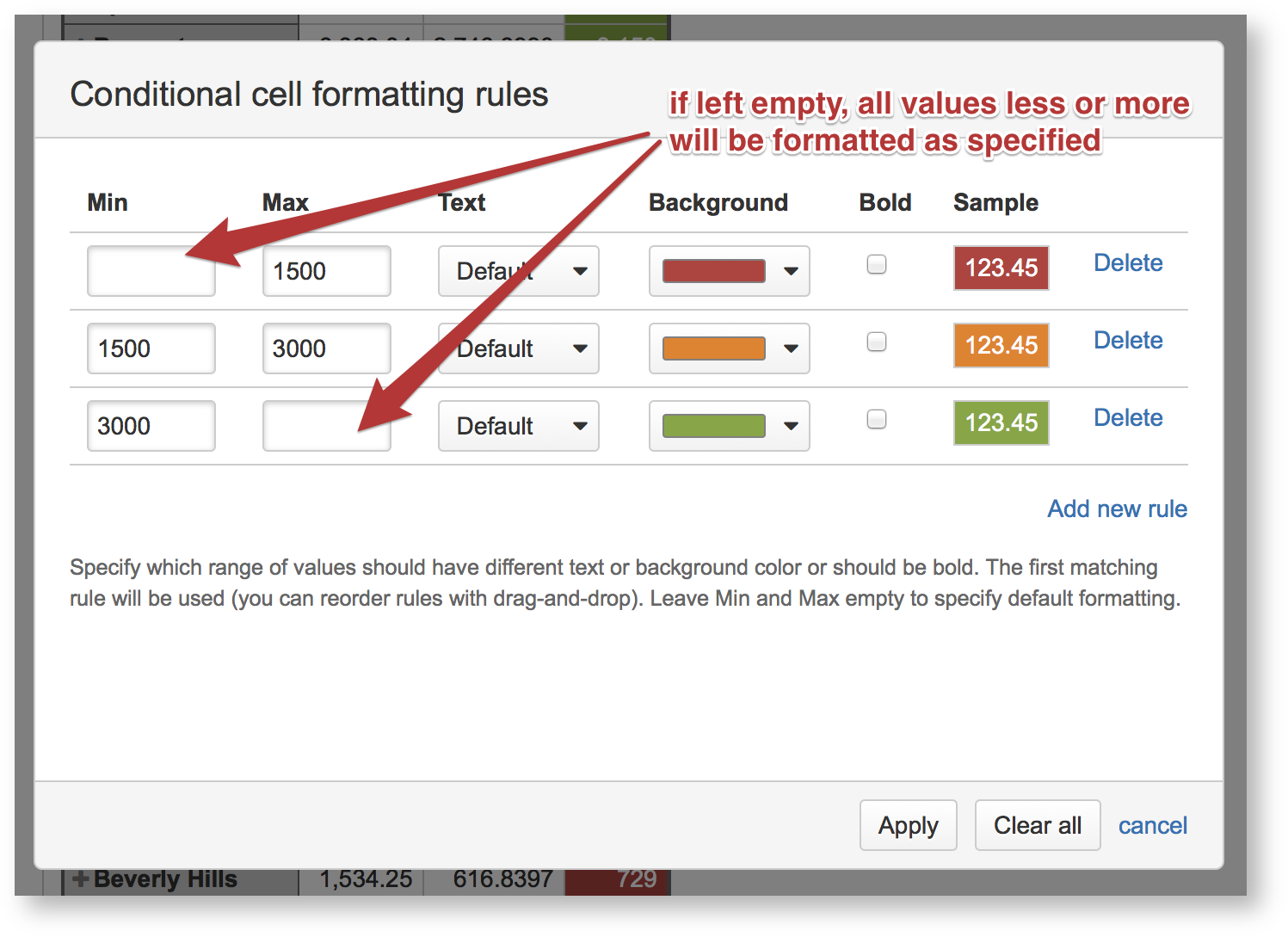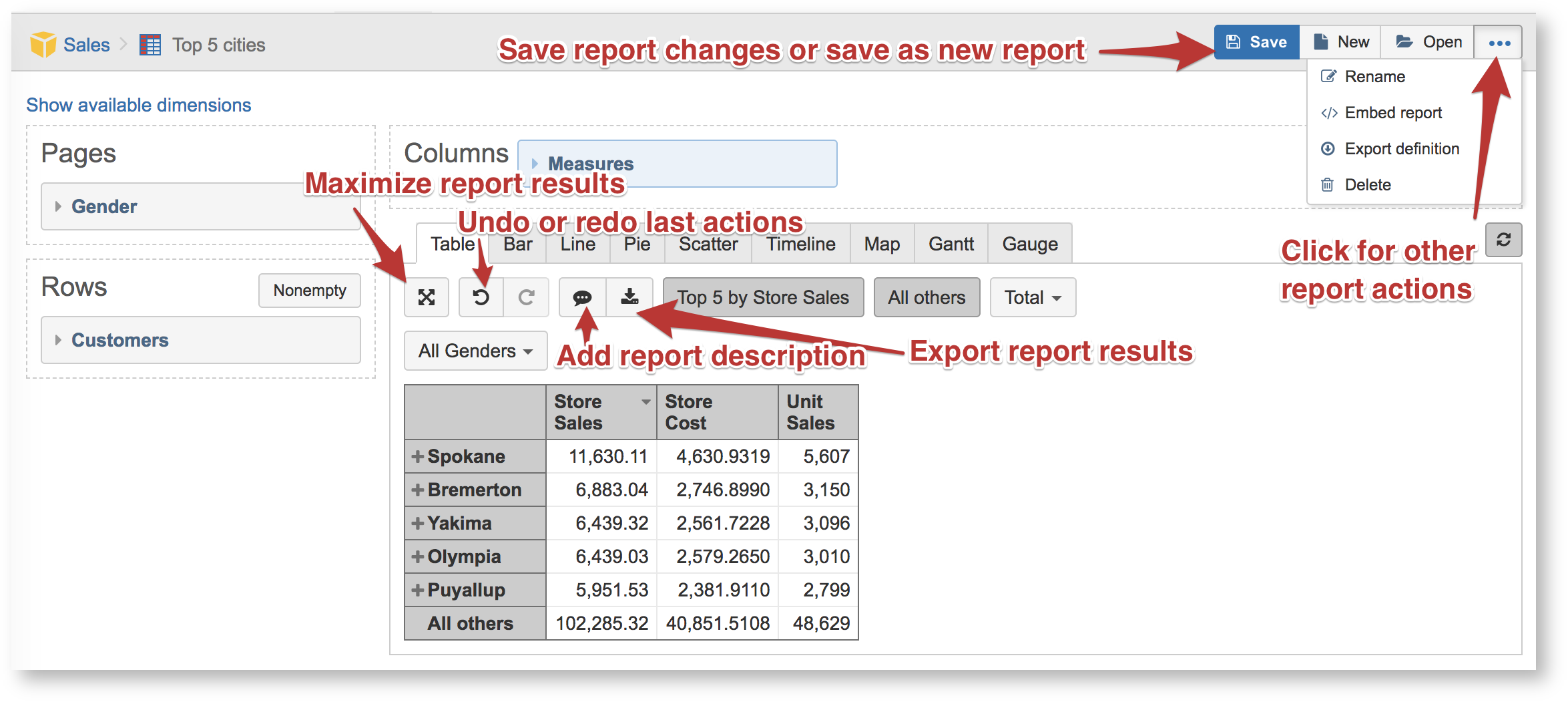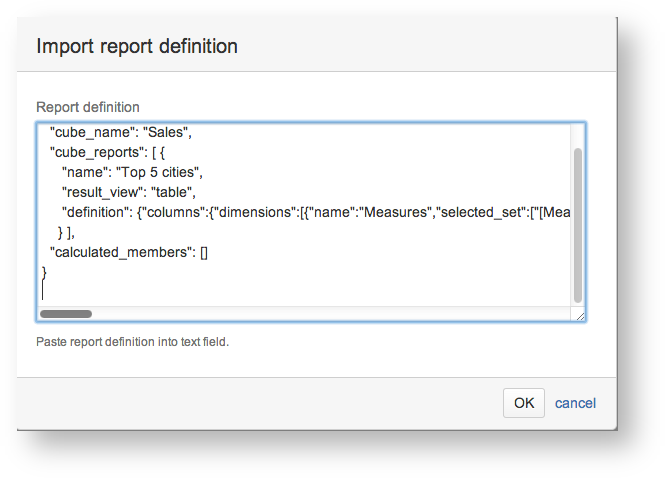Support center for flex.bi version 4.0
Creating reports
All hierarchy level members and member actions
Instead of expanding hierarchy levels from a top you can select all hierarchy level members (e.g. all cities). And then you can order them by selected measure or select other available member actions (e.g. drill into lower hierarchy levels, drill across another dimension, select only one member or remove selected member, select top or bottom rows based on selected measure, filter rows by specified condition). Read also about more advanced filters using date filters and regular expressions.
Conditional formatting on cells
Select Cell formatting to specify the range of values which should have different text or background color in the column or row.
You can also use Cell Formatting to color Text fields; then write the exact text as both Min and Max values. If you have letter-coded field values like A, B, C, D etc, then you can set A as Min and C as Max to color all A, B, Cs.
Add members to Time dimension
The dates in Time dimension are created dynamically - days are added only if there is some activity in the date. If you wish to add some analysis about future or past Time periods that you do not see in Flex.bi, it is possible to add these Time members in Time dimension / All Hierarchy level members.
To add date range you should use exact date name or relative date descriptions. After clicking on OK you will see a confirmation screen with number of how many Time dimension day level members will be created; click 'Yes' to proceed and create new Time dimension members that can be used to show e.g. forecasts or comparison when not all last year data exist.
Page dimensions
If necessary you can drag some dimensions to pages as well and then select one dimension member in page dimension to see corresponding results.
By default all dimension members will be visible and Measures will be showed only where applicable based on filter. If you wish to see only dimension members that have values for selected filters, click on the Nonempty option in the Rows section header. This will make a NonEmpty CrossJoin with selected measures and only show dimension members with Measure values with the selected filter.
Rename row dimension headers
You may add or change a header on columns containing row dimension members [1] . Choose to display the dimension name as a header or, with edit option, type an appropriate one.
Headers of measures can't be changed from the report view [2] . You may change the name of the measure itself (it would affect all reports where the measure is used) or create a new measure (or calculated member for other dimensions) with needed name and then use it instead of originally selected.
Vertical column headers
It is possible to change the table report to show the column headers vertically. The option of the vertical header will appear automatically when the report width exceeds the size of the report design dashboard area, and the horizontal scrollbar will show up.
The “Vertical header” button [1] will show up, and you can turn on the report to show the lowest level column headers vertically.
Save report and toolbar buttons
When you have created report that you would like to use later then save it from report header toolbar. If you edit exiting report and would like to save it as well as keep the previous report, click the save button and give report a new name. This will save the new report as well as leave the previous report as it was. There are also other report actions in the report header toolbar, for example to rename, delete report or embed reports in other HTML pages.
There are options for report result configuration in the report results toolbar that you can try out - maximise, undo, redo buttons as well as adding of report description and exporting results.
This functionality is available starting from the flex.bi version 5.1.
By default, all measures selected in the report columns are cross joined by all members of the dimension selected in the columns with the measures. To cross join only one particular measure with a particular dimension level, you may use option Drill into: click on the measure, select Drill into and the dimension and the member level you need.
For example, if you select to drill into Customers dimension State Province level for measure Store Cost, the Customer dimension would be added to the report Columns next to the Measures and measure Store costs would split by Customer dimension State Province level members. Other measures won't be drilled into this dimension and will be left at the summary level.
Drilling into only one dimension for one measure is allowed in the same report. Changing order of dimensions in Columns (moving Measures after the added dimension) all measures will be drilled into this particular dimension level, which was added through the Drill into option.
You may remove the dimension by clicking on the same measure and using Remove drill into option.
This functionality is available starting from the flex.bi version 5.1
When you have selected some measure for a report, you may Add calculated measure based on the chosen measure and visible data in the report. There is an option to add standard calculated Average, Median, Min, Max, % of total, Cumulative sum, Linear trend, empty values, many "time ago" calculations and empty as 0. with predefined calculation formulas. When you select to add a calculated measure, for example, add calculated % of total, then flex.bi creates an additional column with the calculated percentage for each row from the total value in the all visible report rows; this new calculated measure is report-specific and will not be available for other reports.
You can add more custom hierarchies to the Time dimensions with the Add custom hierarchy option:
There are two types of custom hierarchies possible. First, you can create your custom fiscal hierarchy by selecting the month when your fiscal year starts:
The fiscal hierarchy has the same levels as the default hierarchy of Time dimension (Year, Quarter, Month and Day); it is possible to create only one custom fiscal hierarchy in the account. Fiscal hierarchy year and quarter member names are referenced by the year in which the fiscal year ends.
The other type of custom hierarchies allows creating hierarchies of multiple weeks. You can choose the option of two, three or four-week periods and select a date. The date determines from which day the week count is started:
You can create one instance of each type of the multiple weeks dimension (two, three or four-week periods).
For example, you may create a new hierarchy in the Customer dimension based on the Person code property.
This functionality is available starting from the flex.bi version 6.1
Currently custom hierarchies are supported by Customer, Person, Item, Account, Supplier dimensions. If these dimension members have at least one numeric or string property then you will see the option to add custom hierarchy.
Chose the property by which to group dimension members and add the new hierarchy.
flex.bi will create a new hierarchy with two levels, one representing the property you selected and another representing dimension members.
Export and import report definitions
If you have several Flex.bi accounts or several Flex.bi environments (development, test, produciton) then you can export report definitions from one Flex.bi account and import into another Flex.bi account.
To export individual report definition then click on other report actions in report header toolbar and select Export definition.
You will see report definition in JSON format, please copy this report definition for pasting it in the other Flex.bi environment. Exported report definition will also include all calculated member definitions that are used and needed for this report.
You can also export all report definitions for selected cube from Analyze tab by clicking Export reports (if you have any private reports then they will not be exported in this all reports list).
Now you can visit different Flex.bi account where you would like to import one or several exported reports and click Import reports.
In Import report definition dialog paste previously copied one or several report definition export results.
If there will be any warnings then please review them and confirm that you would like to continue with report import.
After import will be done you will be able to see and use imported reports in this other Flex.bi account.
Report folders
If you have created many reports, then you can create report folders and organize your reports in folders. You can select a folder when saving a new report or move existing report to a selected folder.


























